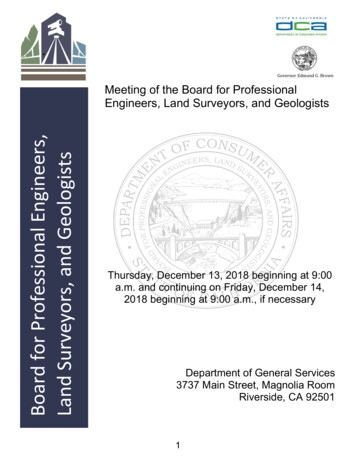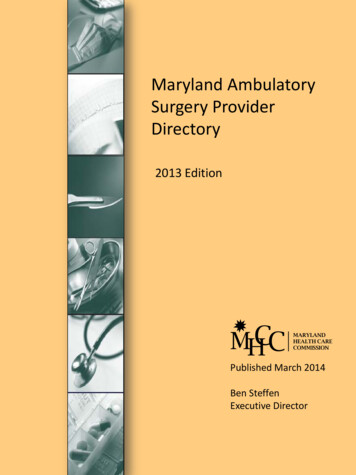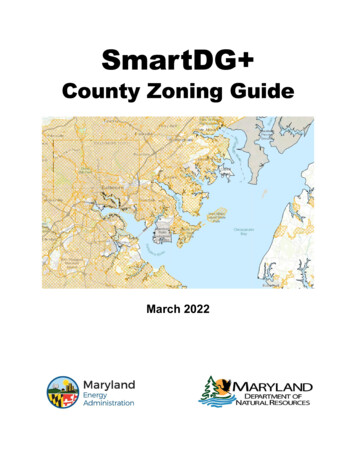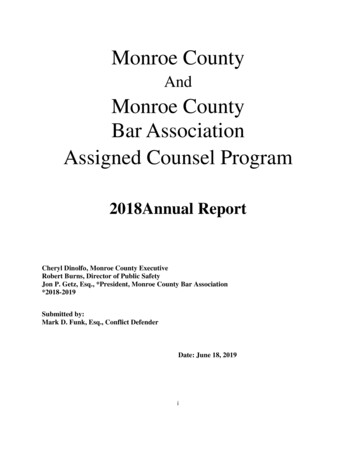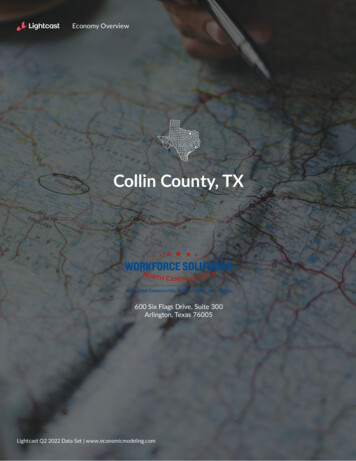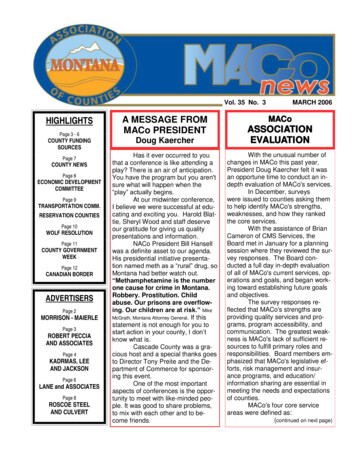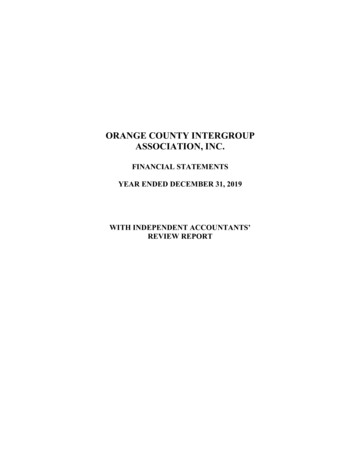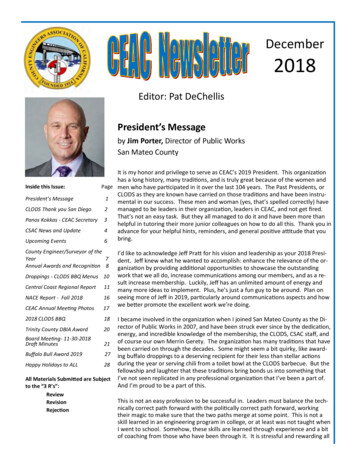
Transcription
December2018Editor: Pat DeChellisPresident’s Messageby Jim Porter, Director of Public WorksSan Mateo CountyIt is my honor and privilege to serve as CEAC’s 2019 President. This organizationhas a long history, many traditions, and is truly great because of the women andInside this Issue:Page men who have participated in it over the last 104 years. The Past Presidents, orCLODS as they are known have carried on those traditions and have been instruPresident’s Message1mental in our success. These men and woman (yes, that’s spelled correctly) haveCLODS Thank you San Diego2managed to be leaders in their organization, leaders in CEAC, and not get fired.That’s not an easy task. But they all managed to do it and have been more thanPanos Kokkas - CEAC Secretary 3helpful in tutoring their more junior colleagues on how to do all this. Thank you inCSAC News and Update4advance for your helpful hints, reminders, and general positive attitude that youbring.Upcoming Events6County Engineer/Surveyor of theYear7Annual Awards and Recognition 8Droppings - CLODS BBQ Menus 10Central Coast Regional Report11NACE Report - Fall 201816CEAC Annual Meeting Photos172018 CLODS BBQ18Trinity County DBIA Award20Board Meeting- 11-30-2018Draft Minutes21Buffalo Bull Award 201927Happy Holidays to ALL28All Materials Submitted are Subjectto the “3 R’s”:ReviewRevisionRejectionI’d like to acknowledge Jeff Pratt for his vision and leadership as your 2018 President. Jeff knew what he wanted to accomplish: enhance the relevance of the organization by providing additional opportunities to showcase the outstandingwork that we all do, increase communications among our members, and as a result increase membership. Luckily, Jeff has an unlimited amount of energy andmany more ideas to implement. Plus, he’s just a fun guy to be around. Plan onseeing more of Jeff in 2019, particularly around communications aspects and howwe better promote the excellent work we’re doing.I became involved in the organization when I joined San Mateo County as the Director of Public Works in 2007, and have been struck ever since by the dedication,energy, and incredible knowledge of the membership, the CLODS, CSAC staff, andof course our own Merrin Gerety. The organization has many traditions that havebeen carried on through the decades. Some might seem a bit quirky, like awarding buffalo droppings to a deserving recipient for their less than stellar actionsduring the year or serving chili from a toilet bowl at the CLODS barbecue. But thefellowship and laughter that these traditions bring bonds us into something thatI’ve not seen replicated in any professional organization that I’ve been a part of.And I’m proud to be a part of this.This is not an easy profession to be successful in. Leaders must balance the technically correct path forward with the politically correct path forward, workingtheir magic to make sure that the two paths merge at some point. This is not askill learned in an engineering program in college, or at least was not taught whenI went to school. Somehow, these skills are learned through experience and a bitof coaching from those who have been through it. It is stressful and rewarding all
President’s Message(continued)President’sMessage (continued)at the same time. And it’s something we should all share and pass on to the next generation of leaders who areamong us today. It is one of the key benefits of participating in CEAC, the fellowship and information sharing that occurs when we get together. Although it is not specifically defined in CEAC’s mission, it is something that this organization does well: preparing the next generation of leaders.So what can you expect to see in the upcoming year? Well, the work that Jeff Pratt started is still in progress and I’dlike to see it continue over the next year. Specifically, the Oversight Committee drafted Charters for each policy committee that includes not only a commitment to evaluate policy issues but also provide presentations that showcaseinnovative projects or programs being implemented by various counties. This is valuable to the membership in thatwe can learn from the best practices of others and learn from the challenges that occurred during implementation.Also, we will be exploring the formation of an Administrative Policy Committee. This new committee will addressmany of the issues that don’t involve ribbon cuttings such as safety and disaster response training, interactions withfederal and state agencies, human resource issues, budgeting, IT, and other issues that we deal with regularly butdon’t fit neatly within the confines of our current policy committees.Finally, I’ve noticed that many of my peers are getting older and see many new (and younger) faces that will be ournext leaders. I mentioned earlier that much of what I believe makes a successful leader is not learned in academia butcomes from experience. During the next year, I will be working with other members of the Oversight Committee orpossibly a new Administration Committee to discuss ways of making this organization more attractive to the next generation of leaders. Possible ideas include a creation of a mentoring program or a scholarship program to get morepeople engaged in the organization. If you have other ideas on how you’d like to see CEAC evolve in the future, pleasereach out to me.Again, thank you for opportunity to serve.Jim PorterThe CLODS wish to thank San Diego County, Richard Crompton, and his staff for all thecoordination and arrangements which made for a very successful2018 CLODS Barbeque - even if there was a little bit of rain.Mehdi Sadjadi, Dave Gravenkamp, Mike Penrose, DeAnn Baker, Ken Miller, Peter Rei, Tim Hackworth, John Presleigh,Doug Wilson, Matt Machado (top of head only), Tom Mattson, Scott McGolpin (eyes only), Julie Bueren, Mort August,and Pat DeChellis - Editor’s Note: this was DeAnn and Mort’s first-time cooking as a CLOD at the barbeque.2
President’s MessagePanos(continued)Kokkas—2018-19 CEAC SecretaryPanos Kokkas was elected as the next CEAC Secretary at the Annual CEAC Meeting heldin San Diego, November 27-30, 2018.Using his own words, Panos is a results-oriented dynamic professional with over 35 yearsof extensive technical and management experience in the public and private sectorsacross the country. He has expertise in the full spectrum of engineering and public worksmanagement, including planning, financing, budgeting, project management, engineering, construction, and operations & maintenance activities for municipalities, counties,state agencies, and utility districts; as well as comprehensive experience in developingand managing Capital Improvement Programs (CIP’s) from inception to implementationand monitoring.In his current role as the Director of the Public Works, County Engineer and Road Commissioner from 2007 to the present for Yolo County, Panos directs and manages all thefunctions of the Public Works Division of a multi-department county agency responsiblefor the County’s transportation & utility infrastructure system, including the countywide Fleet Services Division. Hedevelops and oversees the County’s comprehensive operations, and multi-year CIP for road, bridge, storm drain projects, and service district improvements.Panos began he career in the private sector where he gained experience in design and construction, from small residential to large commercial and large public works projects.In the Town of Danville, he managed the approval process of privately funded projects, both residential and commercial. He then moved to Contra Costa Water District where he worked on unique capital projects. One of the unusualprojects resulted in a subsequent technical paper he co-authored. The paper was selected as one of the topics to bepresented during the tenth earthquake conference in Madrid, Spain. (Bureau, G., & Kokkas, P. “Seismic retrofit of liquid storage tanks.” Earthquake Engineering: Tenth World Conference, Madrid, Spain, 1992). Later, as the Assistant CityEngineer for the City of Brentwood, he advanced his experience in working with elected and appointed city officials,and state agencies.He was a good husband and followed his wife when she was transferred to Illinois. At the Illinois State Toll Highway Authority, he managed large transportation projects. At the same time (1998 to 2005),he was an Adjunct Professor of Management at DeVry University inAddison, Illinois, where he taught Project Management and Principalsof Management courses.While a young engineer in Montana he was the Chairman of theHistory & Heritage Committee, Montana Section of ASCE, 1984. Hecompleted the construction history of “The Going-To-The-Sun Road”in Glacier National Park, on behalf of the Montana Section of theAmerican Society of Civil Engineers (ASCE), and delivered the keynoteaddress in Glacier National Park during the dedication ceremony, whenthe Road was designated a National Historic Civil EngineeringLandmark on July 27, 1985.Panos received a Bachelor of Science degree in Civil Engineering fromMontana State University, and a Master of Business AdministrationDegree from Saint Mary’s College of California. He is a licensedProfessional Engineer in California, Montana, and Illinois.3Panos working on his ranch
President’s Message (continued)News from CSACKiana Valentine’s Departure from CSACAfter more than 12 years with CSAC, Kiana Valentine is moving on. Her time with CSAC and CEAC has been extraordinary and it’s with mixed emotions that we all wish her well. Kiana started with CSAC as a Legislative Analyst, workingunder DeAnn Baker in 2006 and worked her way up to Senior Legislative Representative, working on critical transportation, housing and land use issues. Her most recent success included supporting a strong coalition of local government, labor and business interests to defeat Proposition 6. Her work on the passage of SB 1 and the defeat of Proposition 6 helped to secure billons in transportation revenues. Kiana served a vital function in educating Californians aboutwhat was at risk should Prop 6 pass – specifically educating groups across the state about the specific projects thatwere being funded in their communities and what projects would be on the chopping block if these revenues wentaway. Her hard work and dedication was pivotal to the campaign and defeat of the measure!Kiana is leaving CSAC to venture out into the private sector, joining Politico Group in Sacramento to provide advocacy,consulting and governmental affairs services to clients in the transportation and construction fields. We join with thecounty family in wishing her well in her new endeavors and thank her for her dedication to county government. Shecan be reached at Kiana.Valentine@yahoo.com.Above (l-r): Angie Tate, Robbie hunter, Carolyn Cole,Honorable Governor Jerry Brown, Michael Quigley,Emily Cohen, Graham Knaus, Matt Cate andKiana ValentineAbove: Kiana Valentine and DeAnn Bakerenjoying some time together at the Annual2018-19 CEAC Board ofDirectorsl to r, Jim Porter, President; DougWilson, Parliamentarian; Rick Tippett, Vice-President; Mehdi Sadjadi,Treasurer Emeritus; Jeff Pratt, Immediate Past President; Mike Penrose,NACE Rep; Dave Gravenkamp, Historian; Pat DeChellis, Newsletter Editor;and Panos Kokkas, Secretary. Notpresent—Mike Crump, Treasurer4
President’s Message (continued)Update from CSACCALIFORNIA VOTES TO PROTECT TRANSPORTATION FUNDING, REJECT PROPOSITION 6Voters decisively rejected Proposition 6 at the November 2018 general election, with 56.8% of voters against themeasure and only 43.2% in support. Prop 6 would have repealed the taxes and fees imposed by SB 1 (Beall, 2017),eliminating 5 billion a year in funding for local roads, highways, and transit. The proposition also would have requiredany future fuel- or vehicle-related taxes or fees to be approved by voters after a supermajority vote by the state legislature.Two efforts to repeal SB 1 began only months after the bill was passed in April 2017. Given the significant negative impacts the initiative would have had on the ability of counties to repair and maintain in a safe condition local streets,roads, bridges and other critical local transportation infrastructure, CSAC played a critical role as campaign co-chairalong with the State Building Trades and Construction Council and built a truly impressive coalition of over 670 organizations opposed to this harmful initiative.Campaign polling and research indicated that voters were prepared to reject Proposition 6, but in order to do so, theyneeded to understand the actual negative impacts the measure would have on their local streets and roads and theregional transportation system they rely on in their daily lives. Through SB 1's new robust transparency and accountability requirements, counties and cities had already identified more than 6,500 local projects that would use SB 1 funding in 2017 and 2018. The campaign was able to leverage this information and develop regionalized messages highlighting the significant projects at-risk if Proposition 6 were successful.The campaign strategy was truly impressive and relied on a multi-pronged approach using television, radio, earnedmedia and social media to deliver the No on 6 message to voters. CSAC staff was oftentimes the face of the campaign,debating proponents of the measure in live television and radio debates, taking countless interview requests from media outlets across the state and nation, and speaking at press conferences and rallies.Recognizing the rightful limitations on counties actively advocating a position on ballot initiatives, CSAC staff providedcounties with educational opportunities such as webinars and informational emails outlining what counties could andcould not do while using public resources. At the same time, counties were in a unique position, possessing critical information relevant to voters, to inform the electorate of potential impacts of ballot measures on county functions,programs, and services.CSAC staff prepared numerous resources for counties to use in their educational efforts--and educate counties did!County public works officials from across the state spoke at community meetings, developed lists of at-risk projects,and posted signage on SB 1-funded projects to educate voters about the benefits of SB 1 in their local community.With Proposition 6 behind us, California's counties can continue to repair and rebuild our local transportation infrastructure with the knowledge that a majority of California voters want their roads fixed and recognize that transportation taxes and fees are a sound investment in the state's future.New Affiliate - TranstechTranstech Engineers, Inc. is a distinguished team that has a mix of multidisciplinary expertise that includes Engineering, Design, Planning, andFunding for both the public and private sectors. They are highly experienced in projects and programs involving Civil Engineering, Traffic, Transportation, and Land Use projects with a proven track record in Project,Program, and Construction Management. Established in 1989, Transtechhas the ability to offer an integrated project design and strategy makingus the superior solution for your needs on a variety of projects.Visit www.transtech.com or call (909) 590-85995
President’s Message (continued)Upcoming CEAC Events NACo Legislative Conference - March 2-6, 2019, Washington DC CEAC Public Works Officers Institute (PWOI)/Spring Conference - April 3-5, 2019,Paradise Point Hotel, San Diego NACE Annual Meeting - April 14-18, 2019, Wichita, Kansas CSAC Legislative Conference - April 24-25, 2019, Sacramento CEAC Policy Conference - August 28-29, 2019, Sacramento CSAC 125th Annual Meeting - December 3-6, 2019, San Francisco2018 CEAC Fall Conference/Annual MeetingSan Diego CountyWe want to thank our Sponsors for contributing to another excellent Conference!6
2018 County Engineer and Surveyor of the YearAlexs Jevremovic, Santa Barbara County,Surveyor of the YearPat Minturn, Shasta County, Engineer of the YearImmediate Past President and 2018-2019 PresidentAbove: Jeff Pratt, CEAC’s newest CLOD, andImmediate Past PresidentRight: Jim Porter, 2018-19 CEAC President7
Annual Awards and RecognitionCHICS with their latest two Golden Egg recipients, MelodyDeLeon, 3rd from the right, and Kiana Valentine, 2nd fromthe right.The CHICS Golden Egg Award was created in 2007 byCalifornia’s Honorable Intrepid County Sisters (CHICS)Above: Lourdes Pratt with the Buddy Award inher OfficeJohn Presleigh presenting the Buddy Awardon behalf of his wife, Maren, the 2018recipient, to Lourdes Solorzano, Jeff Pratt'swife, for her dedication and support for Jeff.Above: Pattie McNamee presenting Mort August witha memorial clock - ”It’s Five O’clock Somewhere” at theCEAC Friday Breakfast8
Doug Wilson, above, presenting Mort August, long-time Chair of the Fellowship Committee, with hisCLODS “gear”. Doug, right, installs Mort as an Honorary CLOD as he administers the CLODS Oath to Mortat the CEAC Breakfast Thursday morning at the CEAC Annual Fall Conference in San Diego. Below: Photosfrom the 2018 Annual Meeting.Above, bottom left, seated at the table is Rich Sanders, NACE President, far right, andKevan Stone, NACE Executive Director, to his immediate right9
Bernardino County and dined on steak and chili. The Annual meeting in 1979 was in San Mateo County and thebarbeque was in Half Moon Bay with Pope Como as guestwhich sounds like a story in itself. Steak and chili wereagain the featured menu items. The 1980 event was inOrange County and the barbeque was held in a horse barnnear Anaheim. Lunch featured south of the border menu.The CLODS just completed another “successful” BBQ at theAnnual Conference in San Diego. You ever wonder aboutthe Menu? The following article appeared in the CEACNewsletter 10 years ago (November 2008 Issue) .State Senator Randolf Collier, author of the Collier BurnsAct which established the County Maintained Road System,joined us for lunch in 1981 in Fresno where we again dinedon steak and beans. We were on the beach again in LosAngeles in 1982 with Mexican steak the featured menuitem. This was the year when grilled goat heads made theirfirst appearance at the barbeque. Back in Redding again in1983 we dined on venison stew. San Diego was the barbeque location in 1984 with steak and beans again the staple.Gene Knapp of Solano County, CEAC President 1979, provided surplice “entertainment”. The Oakland Zoo was thesite of the ‘85 event with steak and beans the prime meal.What’s for Lunch? If you are a relative newcomer to ourorganization and have been attending the barbeque for say20 years or less (Editor’s note: now 30 years or less), youprobably think that the menu has always been the same that is: trip, tip, chicken, baked potatoes, chili beans, breadand an assortment of pre-dinner sausages and tasty unknown delights. Well, you are wrong!Two barbeques were held in 1986. The first was in conjunction with the NACE Annual Conference in San Diego.Seems as though the bens saw a little added spice when ajock strap was pulled out during serving. The secondbarbeque that year was held at the famous HollywoodBowl with the toilet making its first appearance as theserving dish for the chili.The first barbeque occurred in Squaw Valley in 1969 andthe menu featured steak and beans. Our annual meeting inthe following year was in San Diego with the barbequepoolside at the Hotel del Coronado. Fish stew was themain course. Ted McConville, Road Commissioner fromOrange County, had taken several of us fishing in Mexicanwaters the day before the barbeque and the group, including me, caught a “ton” of fish. I proudly announced to all atthe barbeque that I had caught the fish for the stew, onlyto find out after the fact that our fish had been dumped.As a result of the actions of many at that event, I’m surethe CLODS will never be allowed to have its barbeque anywhere on the hotel property again or at least until all thatworked there at the time have passed on.From all records, it appears that the first time roast chickenmade its way onto the menu was in Anaheim in 1990. In1991 the barbeque settled in at an old haunt, the LagunaSeca Raceway in Monterey. This may have been the firsttime baked potatoes were included. This barbeque alsofeatured 1969 CEAC President Vic Saurer’s “Living Wake” asthe entertainment of the day. Tri tip, chicken, beans, andbaked potatoes comprised the barbeque menu in 1992 inPalm Springs and that’s been the fare ever since.By Dave “Road Runner” GravenkampCEAC HistorianCLODS BBQ MENUSI am proud to say that with the exception of the 2006event, when my house (nearing completion of construction) burned down days before, I have attended all of thebarbeques. My memory isn’t all that great and I have relied almost entirely on the photo albums of the eventswhich for the first 33 years of the barbeques were proThe 1971 barbeque was on the beach in Montereyduced by Bill McIntosh, aka the Old Crow, and most recent(actually, I think it may have been Seaside) with the mainly by Max Bridges, aka Carrier Pigeon. We usually try tocourse for lunch being a wild pig roasted on a spit. Therewas no barbeque in 1972 for reason I don’t recall; however, display these photos in the Hospitality Suite at conferenceso all of our newer members can get a glimpse of the past.we gathered for lunch at a restaurant atop a mountainabove Palm Springs. The 1973 event took place under aBudge Campbell, aka the Horny Owl, who has done an exbridge over the Sacramento River in Redding and featuredceptionally marvelous job in performing the duties of Chief“hobo” stew. The following year we were again on theCook and barbeque organizer for many years, has anbeach, this time in Anaheim and albacore for lunch.nounced his retirement from these duties and will not beThe barbeque in 1975 was in San Jose with steak, bens, and able to attend this year’s event. Max is organizing thissalad making up the lunch menu. It was back to San Diego year’s event. Come out and see what surprises the newChef has prepared.in 1976 with lunch of an Italian flare. We were in Sacramento in 1977 with the barbeque held at a park in ElkBudge . Many thanks from the CLODS and the CEACGrove, south of Sacramento. The menu featured steak andmembership for your greats barbeques.zucchini with the zucchini being buried and as I recall, never making it to the serving line. In 1978, we were in SanYOU DONE GOOD! AND GOOD! AND GOOD!.10
Central Coast Regional Newssubmitted by: Dave Flynn, Regional Director, San Luis Obispo CountyThe Central Coast Region met in October at the Nacimiento Lake Resort. Our topic of discussion was area dam spillway repairs stemming from the post Orville DWR inspections. Both Monterey and San Luis Obispo County are in theprocess of upgrading the designs originally constructed in the late 1950’s and 60’s. While the Central Coast has seenits share of devastating flooding and mudslides/landslides, we are still dealing with high and lowrainfall and need to manage a great drop in ourreservoir levels. We remain on the verge of implement drought conditions again. However, thelatest forecast for our area indicates a moderateEl Nino condition with expected 110% rainfall.Water levels between spring and fall of Nacimiento lake are shown in these photos. The reservoiris operated by Monterey County Water Agency.Central Coast Region contains five Counties:Monterey, San Benito, San Luis Obispo, SantaBarbara, and Santa Cruz. Highlights from ourregion follow:Santa Barbara County has been inundated with on-going repair work from the Montecito Mudslide tragedy.The County has had roughly a million cubic yards of debris as well as material from their debris basin system hauledoff; much of it trucked to Bulletin landfill. The Montecito area is also seeing many upgrades of bridge which had beendamaged in the event. Preparation of the debris basinsfor this season has been accomplished. Additional stormwater basins have been constructed this past summer.On a brighter note, the County has also replaced a bridgeat Goleta Beach State park entrance which provides aseparated multi-use path and several aesthetic features.The total project was 4.86 million funded under the Federal highway bridge program.11
Central Coast Regional Newssubmitted by: Dave Flynn, Regional Director, San Luis Obispo County (continued)San Luis Obispo County has been working on several bridge projects including a bridge Replacement on AirPark Boulevard in Oceano; a seismic retrofit on Avila Beach Drive, and a new pedestrian bridge in Shandon. Thetarget of the bridge program is to retain an average age of 50 years in its bridge inventory. SB1 revenues will alsoallow the County to pursue replacement of about a dozen short span weight restrictedtimber bridges with pre-cast concrete slabs.The County also completed a new 42 million Airport Terminal inSan Luis Obispo, whichhas received a regionalENR “Project of theYear” Award, and a 38 million Women’s Jailexpansion which included new medicalfacilities. Fundingthrough FAA and CDCRrespectively.San Benito County has been hardpressed to turn around a declining Pavement Condition Rating of 25. The Countypassed Measure G one cent transportationtax in the recent election which will provideimprovements for State Highway 25 butalso provide for some bike & Ped improvements and pavement management. SB1revenues will help in their pursuit of turning the road conditions around but thoseoutlying, low volume agricultural roads remain a daunting task to restore. Meanwhile work under a 1.9 million contract tocreate a Nash Street bypass road is underway to improve traffic flow around the SanBenito High School as well as serve futureaccess to a regional park.12
Central Coast Regional Newssubmitted by: Dave Flynn, Regional Director, San Luis Obispo County (continued)Santa Cruz County - A full depth reclamation pavement rehabilitation project has been completed on GraniteCreek Road and Branciforte Road. The County had received grants to pursue the work and with recent SB1 funds,were able to pursue construction this year.Meanwhile work was completed on the Davenport Sanitation District’s 3.6 million Recycled Water project. Thework included dredging the existing treatment lagoon, installing alarms for the filtration and disinfection processes, and adding coagulant and hypochlorite dosing. Project was entirely funded from outside grants.The County conducted a ribbon cutting ceremony for the Twin Lakes Beachfront Improvement project on July 27th.The 4.7 million project provides enhanced coastal access with dedicated bike lanes as well as stormwater infiltration and public art. The work was funded from numerous grants for coastal access and beach erosion protection.13
Central Coast Regional Newssubmitted by: Dave Flynn, Regional Director, San Luis Obispo County (continued)Santa Cruz County continues to work through over 160 million in storm damage from January-March of 2017.Here is Bear Creek Road PM 8.02 in a before and aftercomparison.And work has begun for a new 7.6 millionLibrary and Discovery Park in Felton. Theroughly 9,000 square –foot facility will beopen in early 2020. Funding for the projectcame from local measure funds, librarybonds and a State grant. The project is managed by Damon Adlao of the Capital ProjectsDivision.14
Central Coast Regional Newssubmitted by: Dave Flynn, Regional Director, San Luis Obispo County (continued)Monterey Countyalso passed a Self-Help transportation tax in 2016 and Measure X funds are proceeding to address highway upgrades around both FortOrd and Castroville to keep pace with development.They are also focused heavily on restoring their pavement conditions with both their Measure X funds andSB1 revenues.The County also saw about 80 million in storm damage from the 2017 storm season of which they havebeen working on repairs. Here is Palo-Colorado Roadalong the Big Sur coast which saw high flows whichdamaged the roadway .Monterey County has also completedconstruction in Spring of the CastrovilleBike/Ped Railroad crossing project. Theoverall project provided a Safe Route toSchool over a ¾ mile distance with thebridge being 12 wide and 1170 feet long.The 10.6 million project provides connections to the Elkhorn Elementary School andNorth Monterey County High School withthe town of Castroville.15
NACE Report - Fall 2018By Mike Penrose, CEAC Representative to the NACE Boardof Directors, Deputy County Executive for Public Works &Infrastructure, Sacramento CountyAs part of the Annual Fall Conference, CEAC invites the President of the NationalAssociation of County Engineers to participate. This year, Rich Sanders, NACEPresident and County Engineer, Polk County, Minnesota, was able to attend.Following is an excerpt taken from the recently published NACE News.I wanted to thank Jeff Pratt and the County Engineers of California for their hospitality.Spent some time with Scott McGolpin, NACE Secretary Treasurer and others enjoying theSan Diego weather. 75 and sunny in late November was tough to deal with after the coldestfall in recent history in Minnesota, which included October snow and cold temperatures.One of the highlights was the CLOD’s barbecue. Chicken, beef, baked beans and playingRural vs. Urban County Engineer Family Feud. Of course, the Rural team won (Editor’sNote: Of course, the Rural Counties won. The Urban Counties have to let them win atsomething!)Upcoming NACE activities includeNACo Legislative ConferenceWashington DC, March 2-6, 2019NACE 2019 Annual MeetingManagement and Technical ConferenceWichita, Kansas, April 14-18, 2019Jeff Pratt, CEAC President, with Rich Sanders,NACE President16
2018 Annual Meeting photosRich Sanders; Merrin Gerety, CEAC ProgramManager; and Jeff Pratt, CEAC PresidentRich Sanders and Scott McGolpin, Santa BarbaraCounty, NACE Weste
rector of Public Works in 2007, and have been struck ever since by the dedication, . he was an Adjunct Professor of Management at DeVry University in Addison, Illinois, where he taught Project Management and Principals . Panos received a achelor of Science degree in ivil Engineering from Montana State University, and a Master of usiness .

